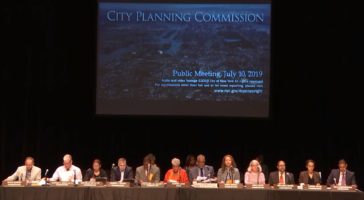
The City Planning Commission at the borough-based jails public hearing on July 10, 2019. Image Credit: CPC
City reduced projected number of beds to 4,600 but did not amend application at time of hearing. On July 10, 2019, the City Planning Commission held a public hearing for the City’s application for four borough-based jails as a part of the City’s plan to shut down Rikers Island. The application proposes four new jails at 124-125 White Street in Manhattan, 745 East 141st Street in the Bronx, 126-02 82nd Avenue in Queens, and at 275 Atlantic Avenue in Brooklyn. The new jails will allow the City to shut down operations on Rikers Island and work toward the City’s goal of reducing the City’s jail population. For CityLand’s prior coverage of the proposed project, click here.
On May 6, 2019, the number of beds needed was reduced from 5,748 to 4,600, to serve a population of 4,000 people instead of 5,000. The reduction resulted from new state legislation that was passed after the application had been certified. This reduction also occurred after the project received backlash over the heights of the proposed jails. As the City adjusted its projection for an achievable reduction in the jail population, a reduced number of beds would also allow for reduced building heights. The project completion time was also moved up from Spring 2027 to June 2026. At the time of the public hearing, the City had not amended the application to reflect reduced beds or building heights.
At the public hearing, Commissioner Kenneth J. Knuckles asked where people in the Manhattan and Brooklyn facilities would be kept as those buildings were demolished and rebuilt. According to Dana Kaplan, the Deputy Director of Close Rikers and Justice Initiatives at the Mayor’s Office of Criminal Justice, the inmates at those facilities would temporarily transfer to Rikers Island as the demolition and construction work was completed. Commissioner Raj Rampershad asked about the recommendations received from the Neighborhood Advisory Committees formed to receive comments about the project. According to Kaplan, based on the recommendations, changes to the plans included the removal of the arraignment court from the Bronx site, the removal of the centralized medical annex from the Queens facility, and a decision to centralize women to the Queens facility. Commissioner Larisa Ortiz questioned the plans for the Brooklyn site’s ground floor retail space given that it currently is only a minimum 20 feet deep, which some potential tenants may consider too shallow.
At the public hearing, 134 people testified and the hearing lasted over seven hours. Overall, the public agreed that the City needed to close Rikers Island but there was disagreement over how to proceed.
Some speakers were in total opposition to the plan, testifying that Rikers should close and not be replaced with any new jails. Activists from No New Jails protested during the presentation and commissioner’s questions, stating that there were no such thing as safe, humane jails and that the City would find ways to fill any and all beds constructed.
Others cited concerns that the new plan fails to require the closure of Rikers Island, and does nothing to ensure the “culture” of Rikers Island does not move to each of the four affected boroughs. Others in opposition were formerly incarcerated on Rikers Island, and questioned the City’s ability to provide the promised social services testified that they were already not receiving the support they needed after they were released.
Others opposed the Bronx site selection process. While the Manhattan, Brooklyn and Queens sites are located close to criminal courts, the Bronx site is approximately two miles away from the Bronx County Hall of Justice and is currently an NYPD tow lot in Mott Haven. Local residents testified that bringing a jail into the neighborhood would undo the efforts of local advocates to reduce gang violence in the area, as members of rival gangs would be brought to the jail. Others questioned why others sites closer to the Hall of Justice were not considered, including the Bronx Family Court building and adjacent lots located next door. According to the City, the size of the lots would require a very tall building to accommodate the number of beds needed.
Speakers in support of the plan argued that this plan was the best shot the City had to close Rikers Island for good. Some of the speakers in support were formerly incarcerated on Rikers Island, and spoke about their experiences, including activists from #CLOSErikers.
Other speakers in support included the Honorable Jonathan Lippman, the former Chief Judge of the New York Court of Appeals and the head of the Independent Commission on New York City Criminal Justice and Incarceration Reform. Judge Lippman emphasized that Rikers was “an accelerator of human misery” that could not be fixed, and needed to be closed.
To watch a recording of the public hearing, click here.
By: Veronica Rose (Veronica is the CityLaw fellow and a New York Law School graduate, Class of 2018.)

